If you’re looking to elevate your healing practice, these 15 Reiki books are a must-have. They cover everything from traditional teachings and symbols to self-healing techniques and modern approaches. Whether you’re a beginner or an experienced practitioner, these titles will deepen your understanding and boost your confidence. From authentic manuals to inclusive guides, each offers valuable insights. Keep exploring, and you’ll uncover the perfect resources to transform your energy work journey.
Key Takeaways
- Highlight authoritative titles like *The Original Reiki Handbook* and *Reiki for Life* for authentic, deepening practice.
- Include comprehensive guides such as *Reiki Manual* and *Reiki Level I, II, & Master Manual* for structured learning.
- Emphasize books that promote self-healing and spiritual growth, like *Chakra Healing* and *Essential Reiki*.
- Consider resources that blend traditional teachings with practical application to enhance healing skills.
- Choose books that cater to all experience levels, from beginners to advanced practitioners, for a transformative learning journey.
Essential Reiki: A Complete Guide to an Ancient Healing Art
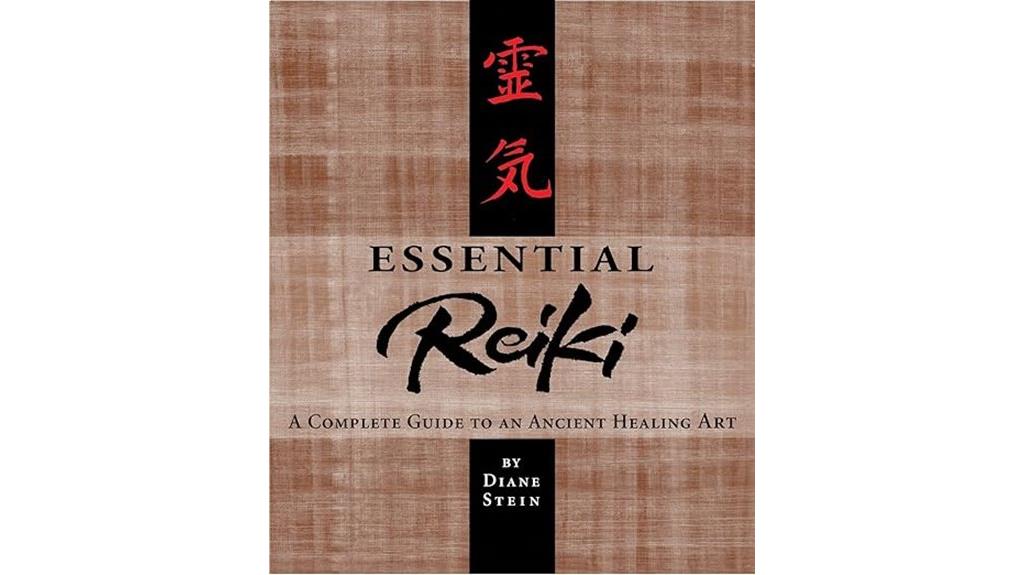
If you’re looking for a Reiki book that makes the healing art accessible to everyone, *Essential Reiki* by Diane Stein is an excellent choice. I appreciate how Stein openly shares the symbols and techniques traditionally kept secret, emphasizing love and universal access. Her background and beliefs, including feminism and Wicca, influence her approach, making Reiki feel inclusive and empowering. The book offers clear explanations, illustrations, and practical guidance, perfect for self-study or supplementing formal training. It’s a thorough resource that demystifies Reiki, helping practitioners at all levels deepen their understanding and confidence in healing energy work.
Best For: those seeking an accessible, comprehensive guide to Reiki that emphasizes love, openness, and empowerment for self-study and supplementing formal training.
Pros:
- Clearly explains Reiki symbols, techniques, and history, making complex concepts easy to understand
- Emphasizes universal access and love, aligning with feminist and Wiccan philosophies
- Includes practical instructions, illustrations, and personal anecdotes that enhance learning
Cons:
- Open sharing of symbols and teachings may upset traditionalists who believe they should remain secret
- Does not replace formal attunements, requiring additional training for full practice
- Some readers may find her perspective influenced by her feminist and Wiccan beliefs, which could feel biased or controversial
Reiki Manual: Training Guide for Students, Practitioners, and Masters
https://m.media-amazon.com/images/I/81Mt4CZFQAL._SY522_.jpg
The Reiki Manual: Training Guide for Students, Practitioners, and Masters stands out as an essential resource for anyone seeking a clear, all-encompassing guide to mastering Reiki at all levels. I’ve found it incredibly helpful for understanding techniques, hand positions, and symbols without confusion. Its practical tips, illustrations, and review questions make learning engaging and accessible. Whether you’re just starting or already practicing, this book offers valuable insights into running a Reiki business and deepening your practice. I appreciate its straightforward explanations, authentic calligraphy of the Reiki Principles, and portable design—making it a go-to reference for ongoing growth and confidence in Reiki.
Best For: Reiki students, practitioners, and masters seeking a comprehensive, easy-to-understand training manual that covers techniques, symbols, business insights, and practical exercises to enhance their practice and confidence.
Pros:
- Clear, thorough explanations suitable for all levels of Reiki practice
- Includes illustrations, authentic calligraphy, and review questions to reinforce learning
- Practical guidance on running a Reiki business and deepening practice
Cons:
- Does not include glyph symbols, only descriptions of their uses
- Might be too detailed for complete beginners who prefer a more condensed overview
- Some users may find the workbook format less suitable for those seeking a purely theoretical resource
Chakra Healing: A Beginner’s Guide to Self-Healing Techniques
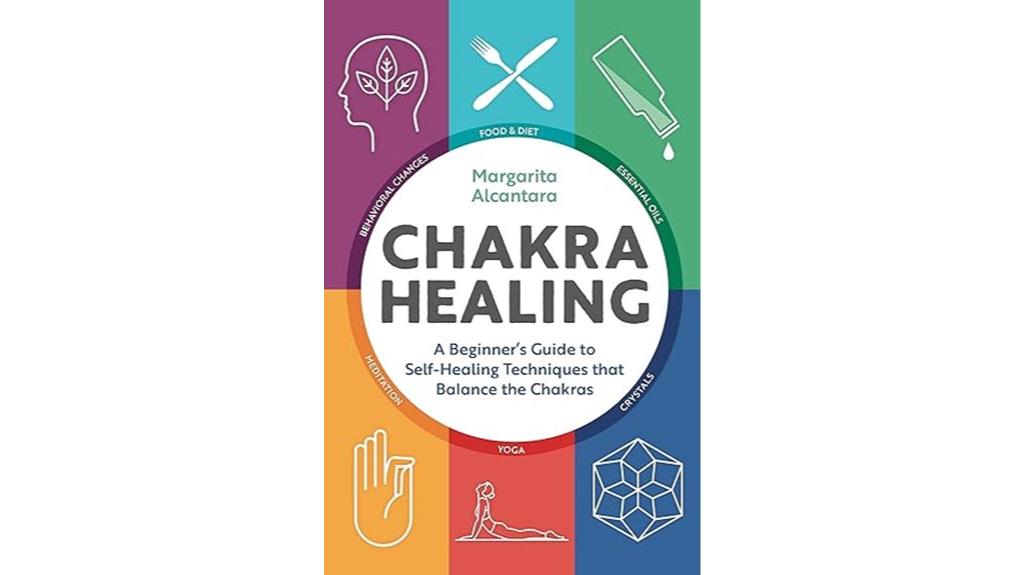
Chakra Healing: A Beginner’s Guide to Self-Healing Techniques stands out as an ideal starting point for those new to energy work and self-healing practices. I appreciate its clear, accessible language that breaks down complex chakra concepts into practical steps. The book covers meditation, crystals, oils, and yoga, guiding me through symptom identification and personalized healing methods. I value its respectful approach to cultural traditions, choosing ethically sourced herbs over appropriative practices. Its structured exercises and visual aids make learning engaging and manageable. Whether you’re just beginning or seeking a practical reference, this book offers valuable tools to deepen your understanding and support your wellness journey.
Best For: beginners interested in exploring accessible, practical chakra healing techniques with a respectful and straightforward approach.
Pros:
- Clear, easy-to-understand language suitable for newcomers.
- Offers practical methods such as meditation, crystals, oils, and yoga with step-by-step guidance.
- Emphasizes cultural sensitivity by recommending ethically sourced herbs and avoiding appropriation.
Cons:
- May be considered light on advanced or in-depth chakra healing content.
- Its simplicity might not satisfy experienced practitioners seeking detailed techniques.
- Physical design, while attractive, might be less practical for frequent referencing.
The Original Reiki Handbook of Dr. Mikao Usui

For those seeking authentic insights into Mikao Usui’s original teachings, The Original Reiki Handbook of Dr. Mikao Usui is a must-have. This manual offers a rare glimpse into Usui’s foundational practices, translated from Japanese and German texts by Frank Arjava Petter and Chetna. It includes detailed hand positions, illustrations, and techniques aligned with Usui’s original methods. The book emphasizes the spiritual roots of Reiki, with background on Buddhist principles and the Three Pillars. Praised for its clarity and depth, it’s perfect for both beginners and seasoned practitioners aiming to deepen their understanding of authentic Reiki practice.
Best For: practitioners and students seeking authentic, detailed guidance on Mikao Usui’s original Reiki teachings, including hand positions, techniques, and spiritual background.
Pros:
- Provides authentic insights directly aligned with Usui’s original practices.
- Richly illustrated with photographs and clear step-by-step instructions.
- Combines historical, spiritual, and practical information, making it suitable for all experience levels.
Cons:
- Focuses heavily on traditional practices, which may not appeal to those seeking modern or alternative methods.
- Some users might find the depth of historical background more than they need for casual practice.
- As a translation of original texts, it may contain language nuances that require careful interpretation.
Reiki Level I, II, & Master Manual

If you’re seeking a reliable, all-encompassing guide to Reiki that bridges traditional teachings with practical application, Lisa Powers’ Reiki Level I, II, & Master Manual stands out as an excellent resource. It aligns perfectly with her popular Udemy courses, providing detailed, clear explanations suitable for beginners and experienced practitioners alike. The manual covers attunements, symbols, and techniques with visual aids that make complex concepts easy to grasp. Its straightforward, factual approach ensures you can revisit and reinforce your learning anytime. Despite minor typos, the manual’s thorough content and practical focus make it a valuable tool for deepening your Reiki practice.
Best For: beginners and experienced Reiki practitioners seeking a comprehensive, clear, and practical manual to deepen their understanding and practice of Reiki.
Pros:
- Clear, straightforward explanations suitable for all levels
- Well-organized content with visual aids enhancing learning
- Complements online courses, serving as a valuable reference tool
Cons:
- Contains minor typos that may require careful reading
- Some traditional symbols may need additional guidance for safe use
- Not designed as a standalone course but as a supplementary resource
The Ultimate Reiki Symbols Guide

The Ultimate Reiki Symbols Guide stands out as an essential resource for practitioners who want to deepen their understanding and mastery of Reiki symbols. Written by a highly regarded Reiki Master, it offers clear instructions on drawing, visualizing, and applying symbols for energy work, protection, and chakra clearing. I appreciate its all-encompassing coverage, including symbols from other healing systems, and practical tips that build confidence—even without formal attunements. The guide’s detailed images and explanations make learning straightforward, inspiring ongoing practice and spiritual growth. Many users find it invaluable for enhancing healing sessions, meditation, and expanding their Reiki knowledge throughout their journey.
Best For: Reiki practitioners of all levels seeking a comprehensive, practical, and inspiring guide to mastering and applying Reiki symbols for healing, protection, and spiritual growth.
Pros:
- Well-written, detailed instructions with clear images and explanations make learning accessible for beginners and advanced practitioners alike
- Extensive coverage of Reiki symbols, including those from other healing traditions, allows for personalized and versatile healing practices
- Inspires confidence and ongoing practice through practical tips, visualization techniques, and real-world applications
Cons:
- The price may be a consideration for some, though many find the value justifies the cost
- Some users may prefer a more concise or beginner-focused guide rather than a comprehensive resource
- As a physical book, it requires space for storage and may not be as portable as digital resources
Reiki Illustrated: Visual Guide of Hand Positions and Symbols
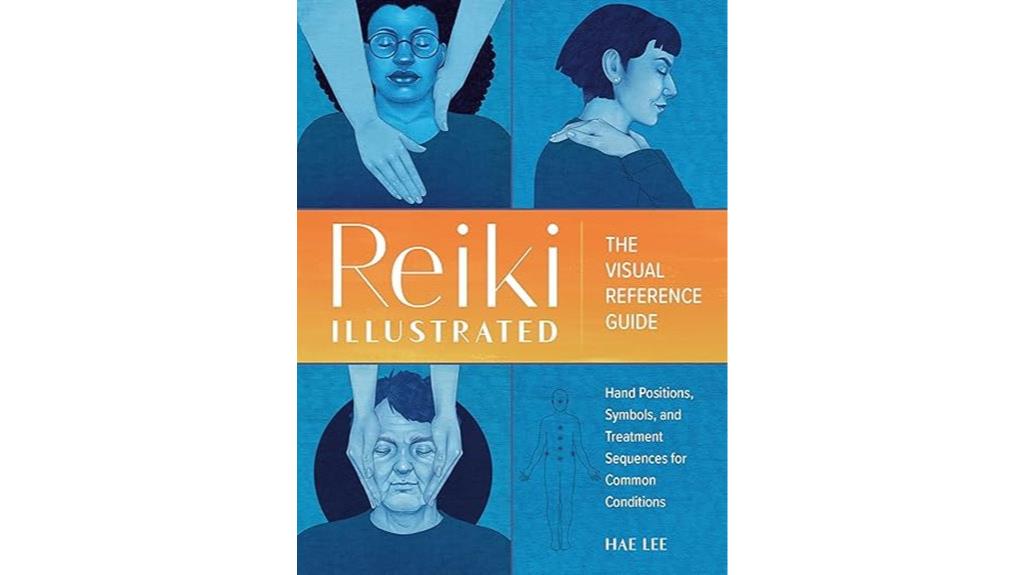
Reiki Illustrated stands out as an essential resource for both beginners and experienced practitioners who want clear, visual guidance on hand positions and symbols. I find its detailed illustrations incredibly helpful for understanding precise movements and treatment sequences. The book covers basic concepts and advanced techniques, making it perfect for learners at any level. Its travel-friendly format and diverse images enhance comprehension, whether I’m practicing in person or remotely. Many users, including myself, feel more confident and prepared after using this guide. It’s more than just a manual—it’s a beautifully crafted visual tool that deepens my understanding and enriches my Reiki practice.
Best For: Beginners and experienced Reiki practitioners seeking clear, visual guidance on hand positions, symbols, and treatment sequences for in-person and remote healing.
Pros:
- Highly detailed and easy-to-follow visual illustrations that enhance understanding of techniques
- Suitable for all skill levels, from newcomers to seasoned practitioners
- Travel-friendly format makes it convenient for practice anywhere, anytime
Cons:
- May require some prior basic knowledge of Reiki for full comprehension of advanced techniques
- Focus primarily on visuals; some users might prefer more textual explanations
- Limited information on theoretical or historical aspects beyond basic concepts
The Art of Psychic Reiki Book

Lisa Campion’s “The Art of Psychic Reiki” stands out as an ideal resource for anyone enthusiastic to explore the psychic dimensions of energy healing, whether they’re beginners or experienced practitioners. The book’s clear, accessible language makes complex topics understandable, emphasizing that everyone has innate psychic abilities. Campion’s candid, reassuring tone offers practical guidance, including exercises for energy cleansing, protection, and developing intuitive skills. With helpful visuals and real-life stories, the book normalizes psychic experiences, empowering readers to embrace their abilities confidently. It’s a valuable tool for enhancing Reiki practice and deepening self-awareness, making it a must-read for those on a healing journey.
Best For: Beginners and experienced Reiki practitioners seeking to deepen their understanding of psychic abilities and energy healing with practical, accessible guidance.
Pros:
- Clear, straightforward language makes complex concepts easy to grasp for all skill levels
- Emphasizes inclusivity and normalizes psychic experiences, boosting confidence
- Offers practical exercises and visuals that enhance learning and self-awareness
Cons:
- Some readers may desire more advanced or technical psychic development techniques
- The focus on beginner-friendly content might limit depth for highly experienced practitioners
- As a book, it may require supplementary training for full integration into professional practice
The 5 Foundations of Reiki Book

Are you looking for an all-encompassing guide that simplifies Reiki’s core principles for both beginners and experienced practitioners? “The 5 Foundations of Reiki” book offers exactly that. It breaks down Reiki’s origins, principles, and benefits into clear, easy-to-understand sections. I especially appreciate how it combines spiritual concepts with practical techniques like hand placements, chakra balancing, and meditation. The book isn’t just theoretical; it provides actionable advice for integrating Reiki into daily life. Whether you’re just starting out or deepening your practice, this guide helps you understand the essential pillars that support effective healing and self-growth.
Best For: individuals seeking a comprehensive, easy-to-understand guide to Reiki that combines spiritual principles with practical techniques for self-care and healing.
Pros:
- Clear and accessible explanations of Reiki’s origins, principles, and benefits
- Combines spiritual concepts with practical techniques like hand placements and chakra balancing
- Provides actionable advice for integrating Reiki into daily routines and personal growth
Cons:
- May be too simplified for advanced practitioners seeking in-depth technical details
- Focuses primarily on foundational principles, with less emphasis on complex or specialized techniques
- Some readers might prefer more visual or step-by-step instructional content
Complete Reiki: The All-in-One Reiki Manual for Deep Healing and Spiritual Growth

If you’re just starting your Reiki journey or seeking a straightforward reference guide, “Complete Reiki: The All-in-One Reiki Manual for Deep Healing and Spiritual Growth” is an excellent choice. I found it easy to read, visually appealing, and packed with helpful tips, making complex concepts accessible. It covers Reiki levels, chakras, meditation, and treatment protocols, offering practical guidance without overwhelming detail. The book’s friendly tone and clear illustrations make it perfect for beginners and those looking to deepen their understanding. I appreciate how it serves as both an introductory manual and a handy reference to revisit during your healing practice.
Best For: beginners, Reiki level 1 practitioners, and anyone seeking an accessible and comprehensive reference guide for deep healing and spiritual growth.
Pros:
- Easy to read and visually appealing, making complex concepts accessible
- Covers essential topics like Reiki levels, chakras, meditation, and treatment protocols
- Serves as a practical, well-organized reference for ongoing practice and learning
Cons:
- Does not delve deeply into advanced Reiki techniques or theories
- Some visuals may change style mid-way, which could be distracting for some learners
- Lacks in-depth historical or technical details for those seeking a more scholarly resource
Crystals for Beginners: Healing Power of Crystals Guide
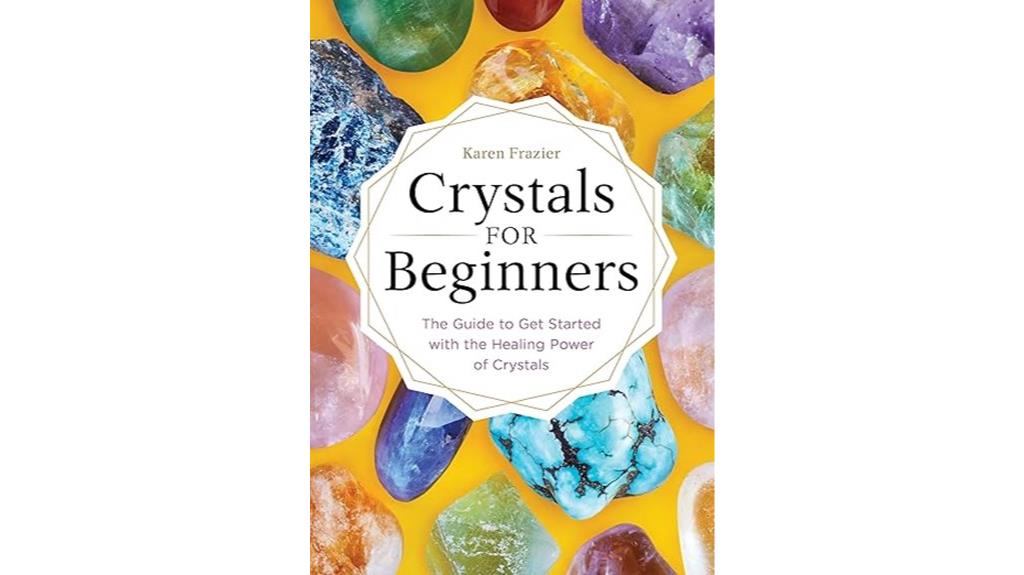
Crystals for Beginners: Healing Power of Crystals Guide stands out as an ideal choice for newcomers to crystal healing who want a clear, visually engaging resource. I find it easy to navigate, thanks to bright pictures and simple tables that help me identify stones and understand their uses. The book combines scientific explanations with spiritual concepts, making it practical and inspiring. I’ve used it daily to select crystals suited to my needs and deepen my practice. Most importantly, it’s approachable for beginners yet extensive enough to support ongoing learning. Overall, I highly recommend it as a trustworthy, beautifully organized introduction to the healing power of crystals.
Best For: beginners and newcomers seeking a clear, visually appealing, and practical introduction to crystal healing and their uses.
Pros:
- Easy-to-understand content with bright pictures and simple tables for quick reference
- Combines scientific explanations with spiritual concepts, making it both educational and inspiring
- Highly recommended for daily use and ongoing learning, suitable for all levels of familiarity with crystals
Cons:
- Some readers have noted minor inaccuracies or discrepancies with personal experiences regarding certain crystals
- The book may not delve deeply into advanced crystal healing techniques for experienced practitioners
- As an introductory guide, it might lack comprehensive details for those seeking in-depth technical knowledge
Reiki for Life (Updated Edition): Complete Guide to Reiki Levels 1-3
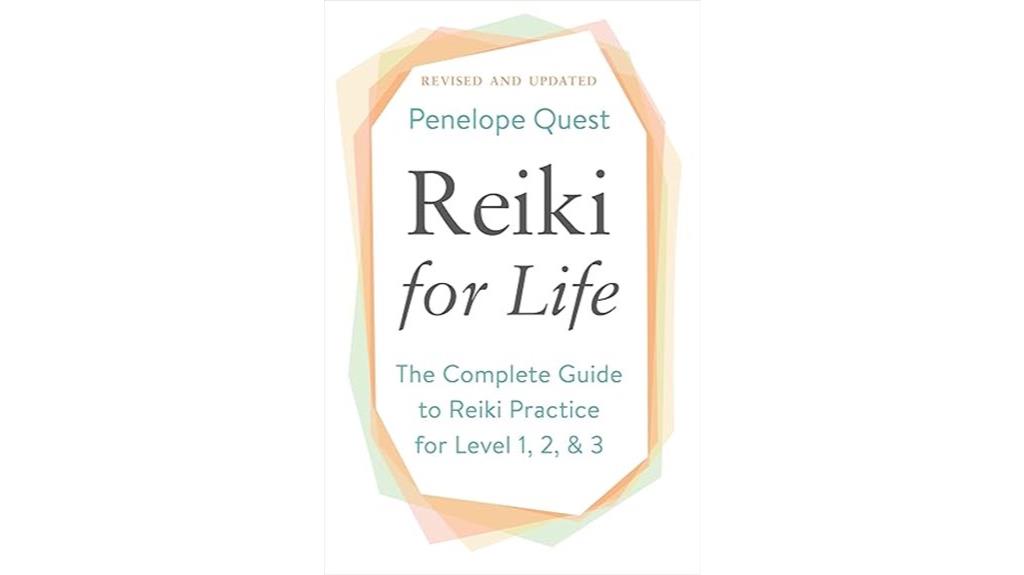
Reiki for Life (Updated Edition) stands out as an essential guide for both beginners and experienced practitioners seeking a thorough understanding of Reiki Levels 1, 2, and 3. Penelope Quest’s inclusive approach offers clear explanations, illustrations, and diagrams that make complex concepts accessible. Whether you’re just starting or deepening your practice, the book covers traditional Japanese techniques and modern adaptations, emphasizing practical application. It encourages hands-on learning, highlighting the importance of attunements and proper training. While some find it straightforward, its detailed content ensures you grasp essential techniques, symbols, and energy development, making it a valuable resource to enhance your Reiki journey.
Best For: beginners and experienced Reiki practitioners seeking a comprehensive, clear, and practical guide to Levels 1-3, including traditional and modern techniques.
Pros:
- Thorough and detailed coverage of Reiki levels with clear explanations, illustrations, and diagrams.
- Balances traditional Japanese practices with modern adaptations, making it accessible worldwide.
- Emphasizes practical application, encouraging hands-on learning and proper training.
Cons:
- Some readers find the book straightforward rather than engaging or captivating.
- The depth of technical detail may be overwhelming for absolute beginners.
- Limited personal anecdotes and insights, which some may desire for a more experiential perspective.
Reiki Healing for Beginners: Step-by-Step Guide

This step-by-step guide is perfect for beginners enthusiastic to learn Reiki in a manageable and structured way. I found it incredibly accessible, with clear techniques that build gradually over 21 days, making complex ideas easy to grasp. The book offers practical guidance, affirmations, and meditation tips that motivate and empower you to start practicing confidently. I appreciate how it combines foundational concepts with advanced insights without overwhelming you. It’s ideal for self-care, healing, or exploring spiritual growth. Whether you’re new to energy work or seeking a straightforward introduction, this guide helps you develop skills at a comfortable pace and fosters a supportive learning environment.
Best For: beginners eager to learn Reiki in a structured, manageable way, seeking practical guidance, confidence-building techniques, and a supportive learning environment.
Pros:
- Clear, well-structured techniques that build gradually over 21 days, making complex ideas easy to understand
- Practical guidance, affirmations, and meditation tips that motivate and empower learners
- Suitable for self-care, healing, and exploring spiritual growth, with a supportive community aspect
Cons:
- May not be ideal for advanced practitioners or those seeking more in-depth, technical expertise
- Some links or techniques could be outdated or less relevant for experienced users
- Supplementary training or resources might be necessary for deeper mastery or beyond beginner level
The Big Book of Reiki Symbols

If you’re serious about mastering the spiritual and symbolic depths of Reiki, The Big Book of Reiki Symbols stands out as an essential resource. This exhaustive guide dives deep into the history, meaning, and cultural roots of Reiki symbols, offering detailed explanations and illustrations. I’ve found it invaluable for understanding the sacred energy practices rooted in Buddhism, Taoism, and Shinto. Its thorough analysis helps me connect more authentically with the symbols, enhancing my meditation and energy work. Whether you’re a beginner or advanced practitioner, this book serves as a rich reference, deepening your appreciation of Reiki’s spiritual and historical significance.
Best For: serious Reiki students and practitioners seeking an in-depth understanding of the symbols’ historical, cultural, and spiritual significance to enhance their practice.
Pros:
- Provides comprehensive explanations, illustrations, and cultural context for Reiki symbols.
- Deepens understanding of the spiritual roots from Buddhism, Taoism, and Shinto.
- Serves as a valuable reference for both beginners and advanced practitioners seeking authenticity.
Cons:
- Can be overwhelming due to its dense and detailed content.
- May require prior knowledge of Reiki or related spiritual traditions for full comprehension.
- Its scholarly approach might be less accessible for those seeking quick or superficial guidance.
The Reiki Manual: A Beginner’s Guide to Healing
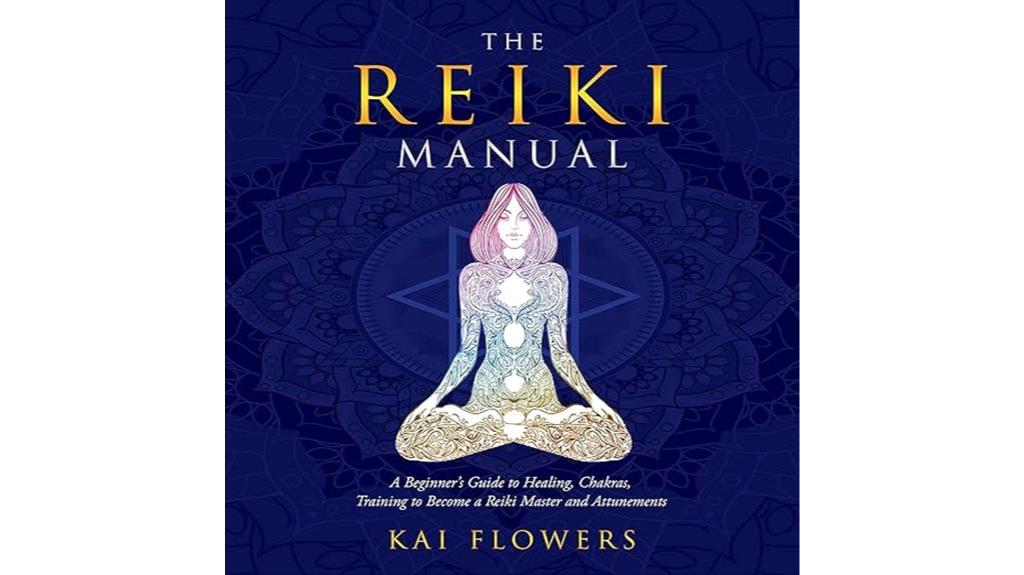
For beginners exploring energy healing, The Reiki Manual: A Beginner’s Guide to Healing stands out as an essential resource. It offers a clear overview of Reiki’s foundations, emphasizing the importance of balancing the 7 Chakras through meditation, mantras, and diet. The book provides straightforward techniques for self-healing, including simple hand positions, visual aids, and tools like crystals. It highlights the significance of attunements and living with intention to deepen practice. Praised for its organized, accessible approach, the manual demystifies Reiki and makes it approachable for newcomers. Many readers find it boosts confidence, emotional balance, and personal growth, making it a must-have for anyone starting their healing journey.
Best For: beginners and those interested in understanding and practicing Reiki for self-healing, emotional balance, and personal growth.
Pros:
- Clear, organized, and accessible explanations of Reiki concepts and techniques
- Practical guidance on self-healing, hand positions, and tools like crystals
- Emphasis on living with intention and holistic well-being
Cons:
- Visual aids like illustrations could enhance understanding of hand positions and attunements
- Some readers may desire more advanced techniques beyond beginner level
- The book primarily focuses on foundational knowledge, so experienced practitioners might seek supplementary resources
Factors to Consider When Choosing Reiki Books
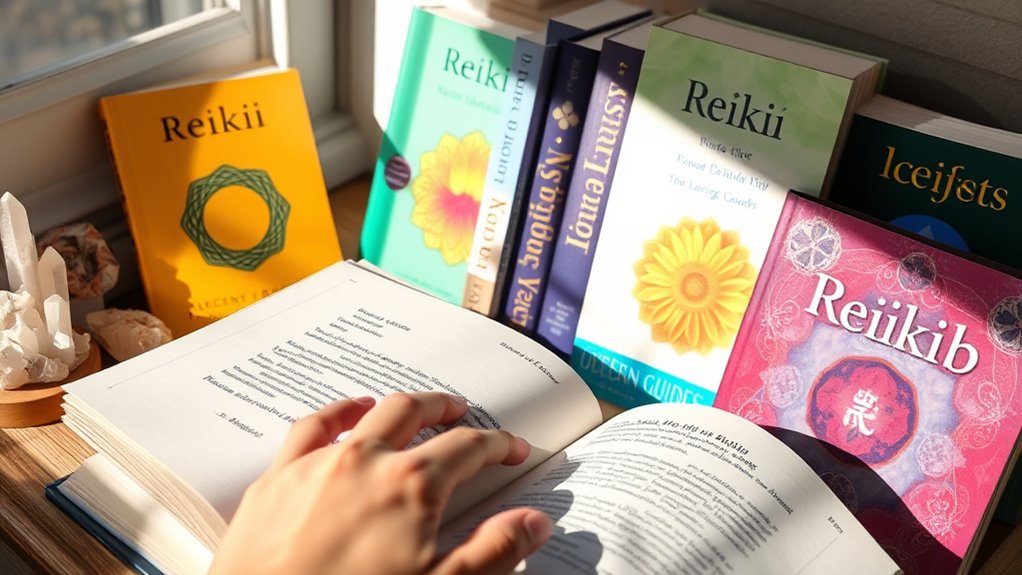
When selecting a Reiki book, I consider the author’s credibility and background to guarantee reliable guidance. I also look at the content’s depth and focus on practical applications that match my level of experience. Finally, I pay attention to cultural context and whether the book suits my learning stage and goals.
Author Credibility and Background
Choosing a reputable Reiki book starts with evaluating the author’s credentials and background. I look for authors with proven expertise in Reiki through their training and hands-on experience, ensuring their insights are authentic. It’s also helpful if they have a background in related fields like energy healing, spirituality, or holistic health, which adds depth to their understanding. I research their reputation within the Reiki community by checking reviews, endorsements, or professional affiliations, which helps gauge credibility. Additionally, I prefer authors who have a history of publishing credible, well-researched information that respects traditional practices. Transparency about their background reassures me they approach Reiki with respect and integrity, making their books more trustworthy and valuable for my learning journey.
Content Depth and Detail
The depth and detail of a Reiki book play a crucial role in how well it supports your learning journey. I look for books that offer a thorough overview or focus on specific areas like symbols, techniques, or history, depending on my needs. It’s important that the content matches my level, whether I’m a beginner or seeking advanced insights. I also value detailed illustrations, step-by-step instructions, and practical exercises that deepen my understanding and skills. Clear, accessible language helps me grasp concepts easily, while balanced traditional teachings and modern perspectives ensure the material aligns with my approach. Ultimately, a well-detailed book empowers me to learn effectively and integrate Reiki more fully into my practice.
Practical Application Focus
To effectively apply Reiki techniques, I look for books that provide clear, step-by-step instructions complemented by visual aids, such as diagrams or photographs, which make practicing these skills straightforward. I focus on resources that emphasize hands-on application, including detailed hand positions, treatment sequences, and symbol usage, so I can translate theory into practice easily. Practical exercises, guided meditations, and protocols that I can incorporate into self-healing or client sessions are essential. I also value books that describe techniques adaptable to different situations, like distance healing or specific ailments, enhancing versatility. Additionally, real-life case examples or testimonials help me understand how others successfully apply these skills, boosting my confidence in using Reiki effectively in various healing scenarios.
Cultural and Historical Context
Understanding the cultural and historical roots of Reiki is essential when selecting a book, as it helps me determine whether the resource respects traditional practices or leans toward modern reinterpretations. Knowing its origins in Japanese spiritual practices connected to Buddhism, Taoism, and Shinto allows me to appreciate its authentic context. I look for books that accurately reference figures like Mikao Usui and include genuine teachings rather than myths. It’s also important to see how the book addresses the transmission of Reiki symbols—whether it emphasizes secrecy or openness—reflecting different cultural perspectives. Additionally, I consider whether the book discusses Reiki’s evolution from its traditional roots to contemporary adaptations, which helps me choose resources that align with my respect for its cultural history.
Audience Suitability and Level
Choosing the right Reiki book depends heavily on matching its content to your current experience and learning goals. If you’re a beginner, look for books that introduce foundational concepts clearly and include practical exercises to build confidence. Intermediate or advanced practitioners should seek books that deepen traditional knowledge or explore specialized techniques. Consider the author’s background—someone with credible experience in Reiki will offer trustworthy guidance aligned with your beliefs. Also, check if the book provides visual aids, step-by-step instructions, or exercises suited to your preferred learning style. Ultimately, ensure the tone and perspective resonate with you—whether traditional, modern, or open-sharing—so that the material feels authentic and inspiring for your personal journey.
Visual and Illustrative Quality
The visual and illustrative quality of a Reiki book plays a vital role in how effectively you can learn and apply techniques. Clear, detailed illustrations of hand positions, symbols, and treatment sequences make complex concepts easier to grasp. Accurate visual aids help you replicate techniques with confidence and precision, especially when you’re just starting out. Well-designed diagrams and images bridge comprehension gaps, providing crucial visual cues for energy flow and positioning. The use of color, shading, and labeling helps distinguish symbols, hand placements, and pathways, making the information more accessible. An aesthetically appealing layout with professional visuals not only engages you but also improves retention of intricate concepts, ultimately enhancing your learning experience and your ability to practice Reiki confidently.
Frequently Asked Questions
How Do I Choose the Best Reiki Book for My Level?
When choosing the best Reiki book for my level, I start by identifying where I am in my practice—beginner, practitioner, or master. I look for books that match my experience, offering clear explanations and practical techniques. I also read reviews and sample chapters to guarantee the writing resonates with me. Trust your intuition and pick a book that inspires you to deepen your understanding and enhance your healing skills.
Are There Specific Books Recommended for Advanced Reiki Practitioners?
If you’re an advanced Reiki practitioner looking for specific books, I recommend exploring titles that explore into energy mastery, spiritual development, and advanced techniques. I personally find books by authors like William L. Rand and Frans Stiene insightful, as they deepen understanding and expand skills. These resources challenge me to grow further and refine my practice, helping me connect more deeply with clients and my own healing journey.
Can These Books Help Me Develop My Intuitive Healing Abilities?
Absolutely, these books can really enhance your intuitive healing skills. I’ve found that reading about different Reiki techniques and philosophies opens my mind to new insights and methods. They encourage you to trust your instincts more and deepen your connection to your energy and clients. By exploring these resources, I’ve noticed my intuition sharpening, making my healing practice more authentic and effective. Give them a try; you’ll likely see similar growth.
Which Books Combine Reiki With Other Holistic Healing Methods?
You’re wondering which books blend Reiki with other holistic healing methods. I’ve found that titles like “The Reiki Sourcebook” by Frank Arjava Petter and “The Healing Power of Reiki” by Raven Keyes explore how Reiki integrates with practices like chakra balancing, meditation, and energy medicine. These books provide practical insights and techniques that expand your healing toolkit, helping you deepen your understanding and effectiveness as a holistic healer.
How Often Should I Revisit Reiki Books to Deepen My Practice?
I believe revisiting Reiki books regularly truly deepens my understanding and enhances my practice. I personally find that every few months, especially after practicing or experiencing new insights, is ideal. This frequent review helps me stay connected, clarify doubts, and incorporate new techniques. Don’t wait too long—consistent revisits keep your energy fresh and your skills sharp, fostering continuous growth on your healing journey.
Conclusion
If you’re serious about transforming your healing practice, these books are invaluable. Did you know that over 80% of Reiki practitioners report increased confidence and effectiveness after studying detailed guides like these? Diving into them can deepen your understanding and enhance your skills. So, pick one that resonates with you, and start your journey toward healing mastery today. Your growth as a healer is just a page away!









